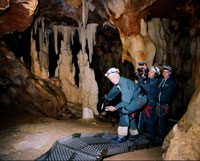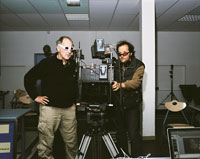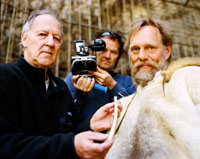 |
|||||||

"Cave of Forgotten Dream" Werner Herzog Documentary is shot with Silicon Imaging SI-3DThe writing was on the wall -- or rather, drawings and artifacts were on the walls of the historic caves of southern France -- in the latest project from acclaimed documentarian Werner Herzog. The first major documentary shot in 3D, Cave of Forgotten Dreams premiered in theaters in 30 U.S. markets in early May. It will eventually air on The History Channel. The inspiration for the documentary stems from an article published in The New Yorker that caught the eye of the film's producer, Erik Nelson, who, with Herzog, took advantage of unprecedented French government-sanctioned access to the renowned Chauvet-Pont-de-d'Arc cave art discovered in 1994 and dating back some 32,000 years. 
"I immediately thought it would be a good subject for a Werner Herzog film," Nelson says, "without knowing anything about Werner's interest in the subject, and was later surprised to discover his similar passion for cave art." As it turns out, in an aura of serendipity, Herzog himself vividly recalls first seeing cave art, in a book in a storefront window as a child. After more than half a year of working odd jobs, he saved up enough money to buy the book with a picture of a horse from the Lascaux caves on it. Thus, the award-winning documentarian of such acclaimed films as The Wrath of God, Grizzly Man and Bad Lieutenant: Port of Call New Orleans required little coaxing to pursue Cave as his next cinematic mission -- after all, the Chauvet Cave contains some of the oldest examples of human art ever discovered -- but deciding how to capture it was entirely another matter. Herzog had never been a big fan of three-dimensional imaging -- and, generally speaking, still isn't. But for this project, producer Nelson thought differently. "I felt this subject really demanded the use of 3D," he says. "It was more a question of, How could we possibly produce it without using 3D? We're taking the audience into a very limited space where normally they cannot go themselves, and so it was mandatory for me that we take them there as effectively as possible." Nelson wound up taking Herzog to the movies to see the James Cameron 3D blockbuster Avatar, and while Herzog did not become a big fan of the sci-fi adventure itself, Nelson says the filmmaker did recognize the added value that the 3D process could bring to certain rare projects. 
Difficult Shoot Environment Because of the physically restrictive shooting environment and a list of protocols the crew had promised to follow -- which forbid typical heat emissions from heavy lighting, for example, and greatly restricted shooting hours -- Herzog, cinematographer Peter Zeitlinger and the rest of the crew had their work cut out for them. "The first time we entered the cave, we had to shoot right away. There was no scouting beforehand," Zeitlinger explains. "Werner Herzog was the only one from the crew who had seen the cave, a few months earlier. We carried this clumsy mirror rig that had proven itself over several commercials in studio conditions, but after a few meters from the entrance to the cave, we decided to leave it behind because it was not possible to squeeze it into the narrow tunnel." The smallest cameras available that could provide 2K resolution were Silicon Imaging SI-2K units, he says. "Since we had only a few hours for the whole film to shoot, we had to shoot no matter what," says Zeitlinger. "Werner said, 'Take gaffer tape, some glue or something, [and] put the cameras side by side and let's go.' But after a moment Werner handed me two [Manfrotto] Magic Arms. I ripped the cameras out of the mirror rig and fixed them side by side on the Magic Arms. Ten minutes later we started to shoot the secret paintings of the cave. I shot from the hip without a viewfinder. We skipped the complicated alignment of the 3D cameras and fixed it later, at night, with the help of CineForm." The 3D aspect required other makeshift solutions. "We found a local [blacksmith] who milled an aluminum bar with several holes and slots so we could mount the cameras at least at the same horizontal level side by side," says Zeitlinger. "The angulations and the intraocular distance could be [adjusted] easily and quickly by loosening one of the screws before every shot. I was flexible for every distance and every focal length, and very quickly got the feeling for the right adjustment without any complicated formulas and calculations. The next day we mounted two GoPro cameras on the new bar, [but] no frame lock was possible," Zeitlinger says. In order to get the side-by-side lenses closer, Zeitlinger turned one of the cameras upside down. Later, he says, they discovered the cameras used rolling shutters, which caused deformed objects in panning shots and other movements. Also, the motion artifacts were different in the left- and right-eye shots. "So we called on Kaspar Kallas of DigitalSputnik in Estonia to try to solve that problem with a software solution. In the end, they dealt with the moving objects manually in every frame," Zeitlinger says. 
Skybot to the Rescue Some of the most impressive shots in the documentary, which were mistaken by some film reviewers as "soaring crane shots," were the result of the latest generation of "skybot," courtesy of Jonathan Watts at British Technical Films. "We had almost finished building the skybot prototype -- a flying hexacopter camera platform -- at the beginning of the shoot in France. And since it might be useful, it went in the van with the rest of the kit," Watts says. "The idea was to design and build a small and highly stable radio-controlled flying machine around a camera, rather than trying to stick a camera on something that could fly." The result, says Watts, was a three-armed hexacopter giving a 120-degree view between the arms -- with no blades above the camera lens to flicker shadows across the lens. Chris Watts, Jonathan's son, mounted a pair of GoPro cameras on the skybot with a bent piece of aluminum and some industrial-strength Velcro, and gave it a go. "Although the results were not completely clean due to the crude mount, the images were very different from anything anyone was expecting," says the elder Watts. The film opens and closes with skybot footage. "3D is challenging at times, without trying to do it inside a dark hole in a cliff somewhere in France," Watts says. For more information about the the Silicon Imaging SI-3D stereo camera system download theSI-3D Brochure.
|
| ®Microsoft Windows XP, Adobe, Adobe Premier Pro, Cineform, ProspectHD, Silicon Imaging. All Rights Reserved. For more information please email us at HD@siliconimaging.com |